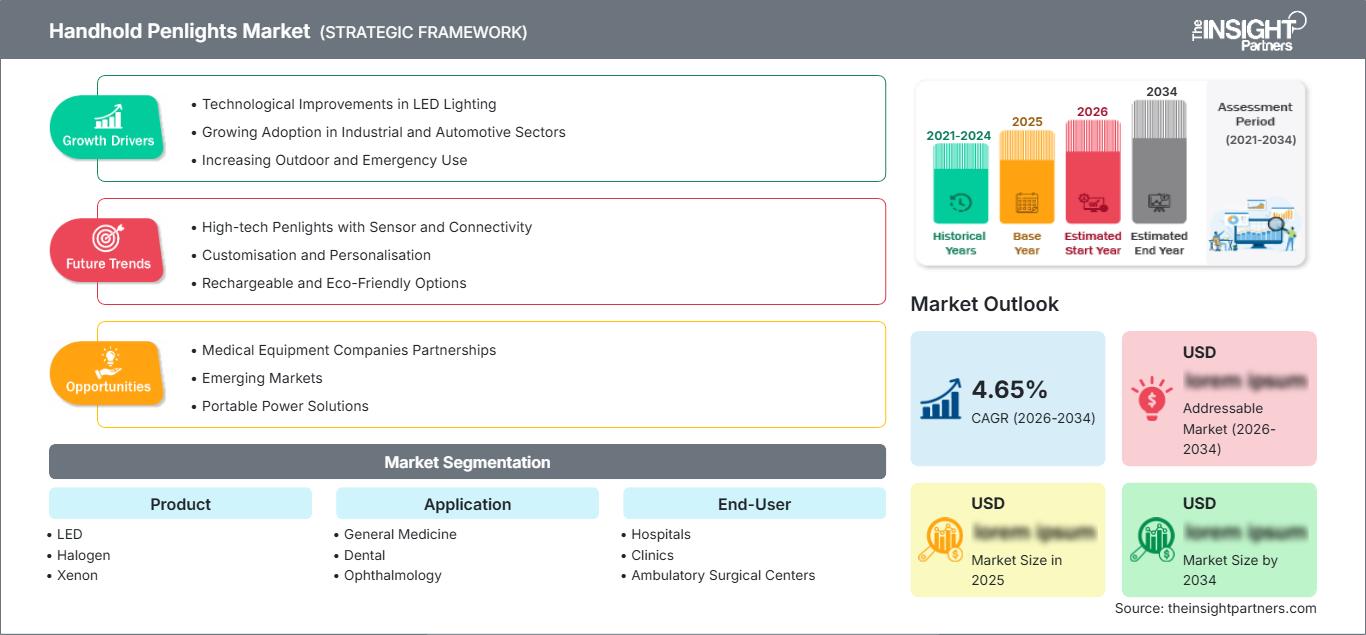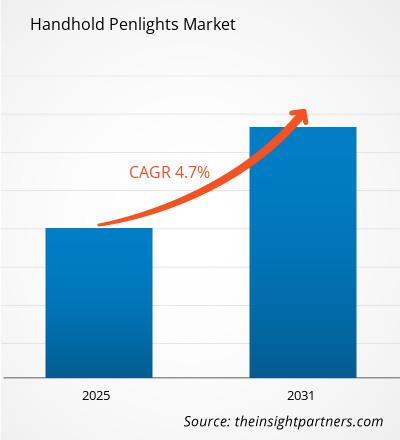Se prevé que el mercado de linternas portátiles se expanda a una tasa de crecimiento anual compuesta (TCAC) del 4,65 % entre 2026 y 2034. Las condiciones del mercado siguen evolucionando, lo que genera nuevas oportunidades para las partes interesadas. El panorama general refleja un progreso estable y un potencial de crecimiento a largo plazo.
El informe presenta un análisis por producto (LED, halógeno, xenón) y por aplicación (medicina general, odontología, oftalmología, otorrinolaringología, etc.). Además, proporciona un análisis por usuario final (hospitales, clínicas, centros de cirugía ambulatoria, etc.). El análisis global se desglosa por región y por país. El alcance del informe abarca el tamaño y las previsiones del mercado a nivel global, regional y nacional para todos los segmentos clave. El informe ofrece el valor en USD de los análisis y segmentos mencionados. El informe proporciona estadísticas clave sobre el estado del mercado de los principales actores y presenta tendencias y oportunidades.
Propósito del Informe
El informe "Mercado de Linternas de Mano" de The Insight Partners busca describir el panorama actual y el crecimiento futuro, los principales factores impulsores, los desafíos y las oportunidades. Esto proporcionará información a diversas partes interesadas del negocio, como:
- Proveedores/fabricantes de tecnología: Para comprender la dinámica cambiante del mercado y conocer las oportunidades potenciales de crecimiento, lo que les permitirá tomar decisiones estratégicas informadas.
- Inversores: Realizar un análisis exhaustivo de tendencias respecto a la tasa de crecimiento del mercado, las proyecciones financieras del mercado y las oportunidades que existen en toda la cadena de valor.
- Órganos reguladores: Regular las políticas y las actividades policiales en el mercado con el objetivo de minimizar el abuso, preservar la confianza de los inversores y defender la integridad y estabilidad del mercado.
Segmentación del mercado de linternas de mano
- CONDUJO
- Halógeno
- Xenón
Solicitud
- Medicina general
- Dental
- Oftalmología
- Otorrinolaringología
- Otros
Usuario final
- Hospitales
- Clínicas
- Centros de cirugía ambulatoria
- Otros
Geografía
- América del norte
- Europa
- Asia-Pacífico
- América del Sur y Central
- Oriente Medio y África
Recibirá personalización de cualquier informe, sin cargo, incluidas partes de este informe o análisis a nivel de país, paquete de datos de Excel, y además aprovechará grandes ofertas y descuentos para empresas emergentes y universidades.
Mercado de linternas portátiles: Perspectivas estratégicas

-
Obtenga las principales tendencias clave del mercado de este informe.Esta muestra GRATUITA incluirá análisis de datos, desde tendencias del mercado hasta estimaciones y pronósticos.
Impulsores del crecimiento del mercado de linternas de mano
- Mejoras tecnológicas en la iluminación LED: Es interesante que la introducción de LED de alto rendimiento sea uno de los principales impulsores de la demanda de linternas portátiles. La tecnología LED garantiza una mayor autonomía de la batería, una mayor eficiencia lumínica y, además, un mayor ahorro de energía. La asequibilidad y la disponibilidad de los LED son algunos de los factores que impulsan la rápida aceptación de las linternas portátiles en diversas industrias.
- Creciente adopción en los sectores industrial y automotriz: Gracias a su pequeño tamaño y precisión, las linternas de bolsillo también se están utilizando en actividades industriales, navieras y de construcción. Quienes trabajan en estos campos necesitan herramientas de iluminación eficaces para revisar máquinas, realizar diagnósticos o en otras situaciones donde la luz debe alcanzar objetos ubicados específicamente. Esta creciente adopción está impactando positivamente en el mercado de las linternas de bolsillo portátiles.
- Aumento del uso en exteriores y emergencias: La necesidad de herramientas de iluminación más prácticas y resistentes ha aumentado a medida que las personas participan más en actividades al aire libre como senderismo, acampada y exploración. Por ello, la comodidad y portabilidad de las linternas portátiles las convierte en un artículo imprescindible en viajes por carretera, situaciones de emergencia y otras actividades al aire libre, lo que explica el aumento de su oferta en el mercado.
Tendencias futuras del mercado de linternas de mano
- Linternas de alta tecnología con sensor y conectividad: Los fabricantes están incorporando sensores y conectividad más avanzados en las linternas portátiles para que los usuarios puedan controlar el nivel de batería, ajustar el brillo o conectarlas con otros dispositivos. Se espera que satisfaga la creciente demanda de soluciones de iluminación multifuncionales en los sectores de la salud, el mantenimiento y otros.
- Personalización: La necesidad de soluciones más personalizadas está impulsando la producción de linternas portátiles personalizadas. Se pueden personalizar logotipos grabados, opciones de color o funciones específicas, como la variación de la intensidad de la luz, que últimamente están ganando popularidad como parte del uso corporativo o promocional en los sectores sanitario e industrial.
- Opciones recargables y ecológicas: La creciente demanda de productos ecológicos y económicos impulsa el desarrollo de linternas recargables. Este modelo está equipado con una batería de iones de litio, eliminando así la necesidad de baterías desechables y ofreciendo una solución más sostenible y duradera para estos mercados, tanto a nivel comercial como profesional.
Oportunidades de mercado de linternas de mano
- Colaboraciones con empresas de equipos médicos: El desarrollo de linternas de bolsillo específicas para profesionales médicos es otra área de oportunidad. En este caso, se trata de un nicho que podría adaptarse perfectamente a las necesidades específicas de la industria sanitaria, con efectos antimicrobianos o sensibilidad a la luz ultravioleta, lo que mejoraría aún más la reputación de la marca y el crecimiento en este mercado.
- Mercados emergentes: Parece existir una gran oportunidad de crecimiento en los mercados emergentes de Asia-Pacífico y Latinoamérica en lo que respecta a las linternas portátiles. La urbanización e industrialización de estas regiones, junto con el alcance de las inversiones en el sector sanitario, están generando una mayor demanda de herramientas de iluminación asequibles y fiables que puedan satisfacerse con la oferta local de productos.
- Soluciones de energía portátiles: La tendencia hacia las soluciones de energía portátiles puede aprovecharse para crear linternas portátiles compatibles con cargadores externos, paneles solares o baterías externas. Esta oferta debe conquistar a los amantes de las actividades al aire libre, los profesionales de preparación para emergencias y las personas que residen en zonas remotas y requieren una iluminación fiable y duradera.
Perspectivas regionales del mercado de linternas de mano
Los analistas de The Insight Partners han explicado detalladamente las tendencias y los factores regionales que influyen en el mercado de linternas portátiles durante el período de pronóstico. Esta sección también analiza los segmentos y la geografía del mercado de linternas portátiles en América del Norte, Europa, Asia Pacífico, Oriente Medio y África, y América del Sur y Central.
Alcance del informe de mercado de linternas de mano
| Atributo del informe | Detalles |
|---|---|
| Tamaño del mercado en 2025 | US$ XX millones |
| Tamaño del mercado en 2034 | US$ XX millones |
| CAGR global (2026-2034) | 4,65% |
| Datos históricos | 2021-2024 |
| Período de pronóstico | 2026-2034 |
| Segmentos cubiertos |
Por producto
|
| Regiones y países cubiertos |
América del norte
|
| Líderes del mercado y perfiles de empresas clave |
|
Densidad de participantes en el mercado de linternas portátiles: comprensión de su impacto en la dinámica empresarial
El mercado de linternas portátiles está creciendo rápidamente, impulsado por la creciente demanda del usuario final debido a factores como la evolución de las preferencias del consumidor, los avances tecnológicos y un mayor conocimiento de los beneficios del producto. A medida que aumenta la demanda, las empresas amplían su oferta, innovan para satisfacer las necesidades del consumidor y aprovechan las tendencias emergentes, lo que impulsa aún más el crecimiento del mercado.

- Obtenga una descripción general de los principales actores clave del mercado de linternas de mano
Puntos clave de venta
- Cobertura integral: el informe cubre de manera integral el análisis de productos, servicios, tipos y usuarios finales del mercado de linternas portátiles, proporcionando un panorama holístico.
- Análisis de expertos: el informe se compila con base en el conocimiento profundo de expertos y analistas de la industria.
- Información actualizada: El informe asegura relevancia comercial debido a su cobertura de información reciente y tendencias de datos.
- Opciones de personalización: este informe se puede personalizar para satisfacer los requisitos específicos del cliente y adaptarse adecuadamente a las estrategias comerciales.
Por lo tanto, el informe de investigación sobre el mercado de linternas portátiles puede ayudar a descifrar y comprender el panorama de la industria y sus perspectivas de crecimiento. Si bien existen algunas preocupaciones válidas, las ventajas generales de este informe tienden a superar las desventajas.
- Análisis histórico (2 años), año base, pronóstico (7 años) con CAGR
- Análisis PEST y FODA
- Tamaño del mercado, valor/volumen: global, regional y nacional
- Industria y panorama competitivo
- Conjunto de datos de Excel
Informes recientes
Informes relacionados
Testimonios
Razón para comprar
- Toma de decisiones informada
- Comprensión de la dinámica del mercado
- Análisis competitivo
- Información sobre clientes
- Pronósticos del mercado
- Mitigación de riesgos
- Planificación estratégica
- Justificación de la inversión
- Identificación de mercados emergentes
- Mejora de las estrategias de marketing
- Impulso de la eficiencia operativa
- Alineación con las tendencias regulatorias






















 Obtenga una muestra gratuita para - Mercado de linternas de mano
Obtenga una muestra gratuita para - Mercado de linternas de mano